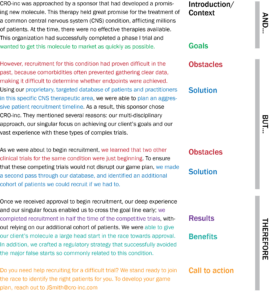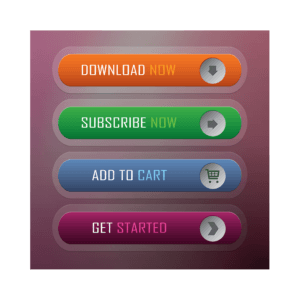The 8 Fundamental Principles Behind the Creation of Compelling Case Studies
By David Chapin

SUMMARY
VOLUME 9
, NUMER 11
I’ve spent the last several issues dissecting the topic of case studies, looking at all the components that make them compelling. When I began the topic, I had no idea it would require such a deep dive. Now that we’re close to the finish line, it’s time to put all these pieces back together. I’ll walk you through the steps to creating a compelling case study—one that allows your prospects to see themselves in the story; one that allows your unique value to come shining through.
Case studies are often misused in creating compelling life science marketing
Case studies can be very effective in creating engagement with your life science marketing audiences. All too often, however, this powerful opportunity is squandered. To enable you to make better use of case studies, I’ve examined the subject of creating compelling case studies for several issues now.
It’s now time to put all these components together, so you can put them to work. I’ll do that by showing you an effective case study example, pointing out the core components and how they work together. And I’ll give you some foundational principles to apply as you build your own case studies. The end result: you’ll be able to harness these principles to write more effective case studies.
The 8 core principles for creating an effective life science case study
To maximize the effectiveness of your case studies, there are eight fundamental principles to which all your life science case studies must adhere. To illustrate these principles, I’ll give you a case study example. In the next issue—the final issue in this series—I’ll show you how you can write a synopsis to set up the creation of an effective case study. In practice, you’ll write the synopsis first, then create the final case study. But in this issue, we’ll look at the final case study first, because it will be easier to illustrate the fundamental principles this way.
Example Case Study
The following case study is just a fictitious example. Any relationship to an existing life science services company is purely unintentional. I could have written this case study for a company that sells products; I’ll show you one of those case studies in the next issue.
The example here might be written by a company that runs clinical trials; let’s give them the generic name CRO-inc. This first version is how the story might appear on their web site (minus any accompanying illustrations or images).
CRO-inc was approached by a sponsor that had developed a promising new molecule. This therapy held great promise for the treatment of a common central nervous system (CNS) condition, afflicting millions of patients. At the time, there were no effective therapies available. This organization had successfully completed a phase I trial and wanted to get this molecule to market as quickly as possible.
However, recruitment for this condition had proven challenging in the past, because comorbidities often prevented gathering clear data, making it difficult to determine whether endpoints were achieved. Using our proprietary, targeted database of practitioners with large numbers of patients in this specific CNS therapeutic area, we were able to plan an aggressive patient recruitment timeline. As a result, this sponsor chose CRO-inc. They mentioned several reasons: our multi-disciplinary approach, our singular focus on achieving our client’s goals and our vast experience with these types of complex trials.
As we were about to begin recruitment, we learned that two other clinical trials for the same condition were just beginning. To ensure that these competing trials would not disrupt our game plan, we made a second pass through our database, and identified an additional cohort of patients we could recruit if we had to.
Once we received approval to begin recruitment, our deep experience and our singular focus enabled us to cross the goal line early; we completed recruitment in half the time of the competitive trials, without relying on our additional cohort of patients. We were able to give our client’s molecule a large head start in the race towards approval. In addition, we crafted a regulatory strategy that successfully avoided the major false starts so commonly related to this condition.
Do you need help recruiting for a difficult trial? We stand ready to join the race to identify the right patients for you. To develop your game plan, reach out to JSmith@cro-inc.com
An effective case study
When you read this case study, did you get a clear sense of what the organization was facing, and how they handled this challenge? It is pretty clear, isn’t it?
So it’s a good choice to illustrate the eight fundamental principles that all effective case studies must embody. (The first principle is first for a reason: it’s the most important.)
Core principle #1: Your case study must follow the A-B-T story structure

The three-act structure that creates compelling story structure can easily be summarized: ____ and ____, but ____, therefore ____.
I’ve written in the past two issues about how and why the And…But…Therefore… structure is so important and so effective. You can learn more here and here. I won’t rehash all this material again, except to say that this structure is crucial if you want to engage your audiences. So you must organize your case study so that it follows the A-B-T structure.
The first part of the A-B-T structure sets up the situation, the second part introduces the tension, and the third part resolves that tension. Does the CRO-inc case study clearly follow this structure? Yes: the first paragraph defines the situation (the And…). The second and third paragraphs introduce—and then ratchet up—the Tension (the But…). And the resolution of this tension (the Therefore…) comes in the fourth paragraph. You can see this breakdown in Figure 1—which also provides a more detailed, color-coded review of the important components of any case study: Introduction/context, Goals, Obstacles, Solution, Results, Benefits and Call to action.

In a previous issue, I discussed the need to include the following components in an effective case study: Introduction/context, Goals, Obstacles, Solution, Results, Benefits and Call to action. You can see those components in the color-coded example here, all of which fit into the And…But…Therefore structure.
If you want your case studies to be effective, make sure they adhere to the first fundamental principle: your case study must follow the A-B-T structure.
You can have more than one B-T
It is worth pointing out that you can have serial Bs & Ts. In the example we’ve been discussing, there are two “Buts” where the tension gets increased. First, when comorbidities had made recruitment difficult in the past. And then, when two other, competitive trials started.
Hollywood movies, like Star Wars, Episode 4, or novels like The DaVinci Code by Dan Brown, often have multiple sessions where the tension gets increased, slightly decreased and then increased again.
Treating the tension of your A-B-T in this way ads flexibility to the case study creation process.
Core principle #2: Your case study must clearly define the context
Your case study will exist in several places: in a sales presentation, on your web site, in a free-standing PDF, to name the major ones. In the last two of these cases, your readers may come to this material cold, with little or no sense of the context in which the case study exists. So, your case study must clearly define the context within which your story takes place.
Does the CRO-inc case study clearly define the context—the environment within which the case study occurs? Yes, the context is clearly established in the first paragraph. It’s clear that this story relates to Phase II clinical trials and the issues surrounding patient recruitment for a specific CNS condition.
Making the context crystal clear seems like such a simple thing that it’s not worth devoting a core principle to it. But too many case studies omit this important point, leaving readers confused from the very start.
Core principle #3: Your case study must clearly define the protagonist
Your case study must make it clear who the “hero” of the case study is. It’s all too easy to say, “Well, my
company should be the hero of this story,” but you must remember that we’ll increase engagement if we let our prospects see themselves in the case study. So it’s typically better to make a customer the hero of your case study—while making it obvious that your focus (which I’ve defined here as a combination of your unique value and your approach) was the key enabler of their success.
Does the CRO-inc case study clearly define the protagonist? Yes, it’s clear that the protagonist is a sponsor organization with a CNS therapy in phase 2 clinical trials. Framing the case study in this way allows any company in a similar situation to see themselves as the protagonist of a story just like this one—one with a happy ending made possible by CRO-inc.
Core principle #4: Your case study must clearly define the protagonist’s goal
To engage our audiences, we use tension. This tension will come from an interruption in the protagonist’s progress towards their goal. To make the tension as clear as possible, we have to clearly define the
protagonist’s goal in the case study.
Does the CRO-inc case study clearly define the protagonist’s goal? Yes, the sponsor wanted “to get this molecule to market as quickly as possible.” This required another clinical trial, and a whole new set of patients. Any company facing a clinical trial will have similar goals.
Core principle #5: Your case study must clearly define the source of tension
Tension drives interest. If the problem being presented by the case study is not difficult to solve, the case study will come off as a weak example of the value being offered. Then the audience might think, “Well, anyone could have done that.” Instead we want our audiences to think: “I understand the goal, but look at all the obstacles in their way. How in the heck did they solve that thorny problem?” To encourage this, we must use tension, presented through the A-B-T framework.
Does the CRO-inc case study clearly define the source(s) of tension? Yes, the tension is introduced in the second paragraph, when the following issues are presented:
- Recruitment of these patients had proven challenging in the past
- Comorbidities are common for this condition, making it difficult to determine whether the endpoints are being reached.
- Two other clinical trials for a similar indication were just beginning
Your case study must clearly define the source of tension. The greater the tension, the better. The more difficult the challenges you are able to address, the more potential value you offer.
Core principle #6: Your case study must clearly communicate your position (or at least your unique value)
Your position clearly states many things, including what you offer, who you offer it to, and why your offering is different and better. The core of your position is your unique value proposition. While it may be a small overstatement, all of your marketing touchpoints should communicate your unique value. This is especially true of your case studies.
Does the CRO-inc case study clearly communicate the unique value that CRO-inc offers? Well, some of the unique value comes through in the second and third paragraphs, doesn’t it? There is discussion of “vast experience,” a “proprietary, targeted database of patients and practitioners in this specific CNS therapeutic area,” and “an aggressive patient recruitment timeline.”
These factors by themselves are not enough to allow an audience member to identify every detail of CRO-inc’s position, but they certainly help highlight some of the unique value that CRO-inc offers. Similarly, your case study must make your unique value clear.
Core principle #7: Your case study must have a clear tone of voice
The tone of voice used in your case studies must be consistent with the tone of voice in all your other marketing communications. Driving this consistency is much easier if you use an archetype to clearly define your organization’s tone of voice. For more on the use of archetypes, see this article.
Does the CRO-inc case study have a clear tone of voice? Well, a good way to examine tone of voice is to pay attention to the modifiers that give language its “flavor”: the adjectives and adverbs. In the CRO-inc case
study, we can find the following modifiers:
multi-disciplinary (approach)
singular (focus)
vast (experience)
proprietary, targeted (database)
this specific therapeutic (area)
aggressive (patient recruitment timeline)
deep (experience)
Other words of note:
cross the goal line early
a large head start in the race (towards approval)
the major false starts
ready to join the race
develop your game plan
What archetype might this represent? Any one word by itself isn’t enough to give us the answer, but when you take them all together, it sounds like an “Athlete.” The Athlete typically appears as one who is focused, achievement oriented, able to endure hardships, and multi-disciplinary (focused on strength conditioning and psychology and diet and agility training, etc., etc.), among many other attributes.
While we can’t determine from this one example whether all of CRO-inc’s touchpoints embody this same tone of voice, there is a clear tone of voice in this example.
Core principle #8: Your case study must have a clear call to action
The point of all marketing it to create a change—a change in attitude, belief or behavior. So you must incorporate a call to action into your A-B-T synopsis and into your final case study. Does the CRO-inc case study have a clear call to action? Yes, the reader is invited to contact the company if they have a need to recruit for a difficult trial.
The core principles
To create an effective case study, you can use the following questions as a guide to ensure that the 8 core case study principles are followed. It’s best if you answer the questions in the order they’re presented here.
- Is the case study story organized according to the And…But…Therefore… structure?
- What is the context? In what situation does the story occur?
- Who is the protagonist? Who is the “hero” of the story?
- What is the protagonist’s goal? What are they trying to accomplish?
- What is the source of tension? What stands in the way of the protagonist achieving their goal?
- Is the marketing position clear? Is unique value being presented in a compelling fashion?
- Is the tone of voice clear and distinct? Is the tone of voice consistent with other communications from the organization?
- What change in attitude, belief or behavior is sought? Is there a clear call-to-action?
Creating an A-B-T summary to simplify the creation of your case study
Writing a case study from scratch is pretty difficult. (Maybe that’s why there are so many ineffective case studies out there.) So in the next issue, I’ll share a two-step process—one that is much easier than starting from scratch—for simplifying and speeding your way toward generating a compelling case study. The first step is to create a summary form of the case study—an outline—that will guide you in creating your final, public-facing case study. The rules for creating this case study outline are pretty simple, and if you follow them, you’ll be able to separate the three distinct, and difficult, tasks: determining what content you need to include; creating an effective structure; and creating the final, public-facing language. Splitting these tasks in this way will make it easier to create a compelling case study.
Conclusion
There are 8 foundational principles you must follow as you write your case study. I’ve outlined them in this issue. Your case study must:
- follow the A-B-T story structure
- clearly define the context
- clearly define the protagonist
- clearly define the protagonist’s goal
- clearly define the source of tension
- clearly communicate your position (or at least your unique value)
- have a clear tone of voice
- have a clear call to action
In the next issue, I’ll guide you through the creation of an intermediate step: a case study synopsis. You’ll then have everything you need to create a compelling case study, and we’ll finally be done with this long series of whitepapers on creating compelling case studies.
The Marketing of Science is published by Forma Life Science Marketing approximately ten times per year. To subscribe to this free publication, email us at info@formalifesciencemarketing.com.
David Chapin is author of the book “The Marketing of Science: Making the Complex Compelling,” available now from Rockbench Press and on Amazon. He was named Best Consultant in the inaugural 2013 BDO Triangle Life Science Awards. David serves on the board of NCBio.
David has a Bachelor’s degree in Physics from Swarthmore College and a Master’s degree in Design from NC State University. He is the named inventor on more than forty patents in the US and abroad. His work has been recognized by AIGA, and featured in publications such as the Harvard Business Review, ID magazine, Print magazine, Design News magazine and Medical Marketing and Media. David has authored articles published by Life Science Leader, Impact, and PharmaExec magazines and MedAd News. He has taught at the Kenan-Flagler Business School at UNC-Chapel Hill and at the College of Design at NC State University. He has lectured and presented to numerous groups about various topics in marketing.
Forma Life Science Marketing is a leading marketing firm for life science, companies. Forma works with life science organizations to increase marketing effectiveness and drive revenue, differentiate organizations, focus their messages and align their employee teams. Forma distills and communicates complex messages into compelling communications; we make the complex compelling.
© 2024 Forma Life Science Marketing, Inc. All rights reserved. No part of this document may be reproduced or transmitted without obtaining written permission from Forma Life Science Marketing.








